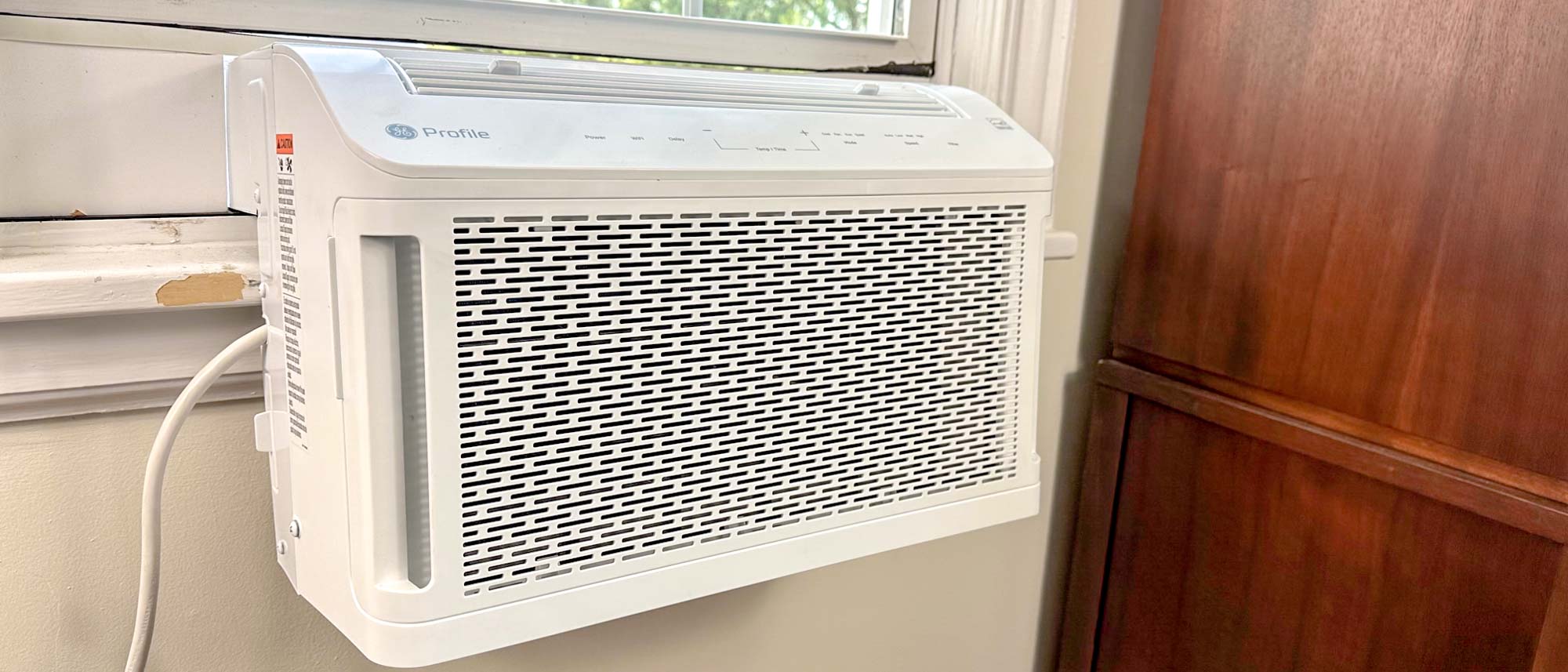Tom's Guide Verdict
The GE Profile Clearview Window air conditioner has a U-shaped design that lets more light in through your window. It’s quiet and efficient, but we found it trickier to install than other, less expensive models like the Midea U.
Pros
- +
Quiet
- +
Efficient
- +
Lets more light through window
Cons
- -
Tricky installation
- -
Remote control buttons hard to read
- -
More expensive than competition
Why you can trust Tom's Guide
BTUs: 10,300, 12,200
Room size: 350-450, 450-550
Energy Efficiency Ratio: 14.6
Works with: Alexa, Google Assistant, IFTTT
Size: 28 x 19.6 x 12.8 inches
Weight: 80 pounds (10,300 BTU model)
One of the biggest drawbacks to window air conditioners is that they block a good portion of your window, and the plastic baffles are both flimsy and do a poor job with insulation. The Midea U smart air conditioner was the first to solve this problem, which is a design that lets you slide your window down between the two halves of the air conditioner. However, it still blocks a good amount of light from getting in.
The GE Profile Clearview window air conditioner (from $429) rectifies that problem by essentially turning the U upside down — so it's more like an "n." The Clearview hangs mostly below your window, which allows more light in. On top of that, this model also uses inverter technology to cool your room, which is not only quieter, but more efficient than older-style air conditioners. Is this the best smart window air conditioner you’ve been looking for? You’ll have to read the rest of this review to find out.
GE Profile Clearview Window air conditioner review: Price and availability
The GE Profile Clearview Window air conditioner went on sale in the Spring of 2023, and is available in two sizes. A 10,300 BTU unit costs $529, while a 12,200 BTU unit costs $579. The smaller model should be good for rooms from 350-450 square feet, while the larger model is good for rooms from 450 to 500 square feet.
GE also makes the Clearview in 6,100 and 8,300 BTU sizes, but these models do not feature inverter technology, so they’re louder and less efficient than the inverter-style models.
GE Profile Clearview Window air conditioner review: Design
Like the Midea U air conditioner flipped upside down the GE Profile Clearview is shaped sort of like a lowercase n, or a horseshoe held upside down. The exterior section houses the bulk of the air conditioner, while the interior section has the controls and output.
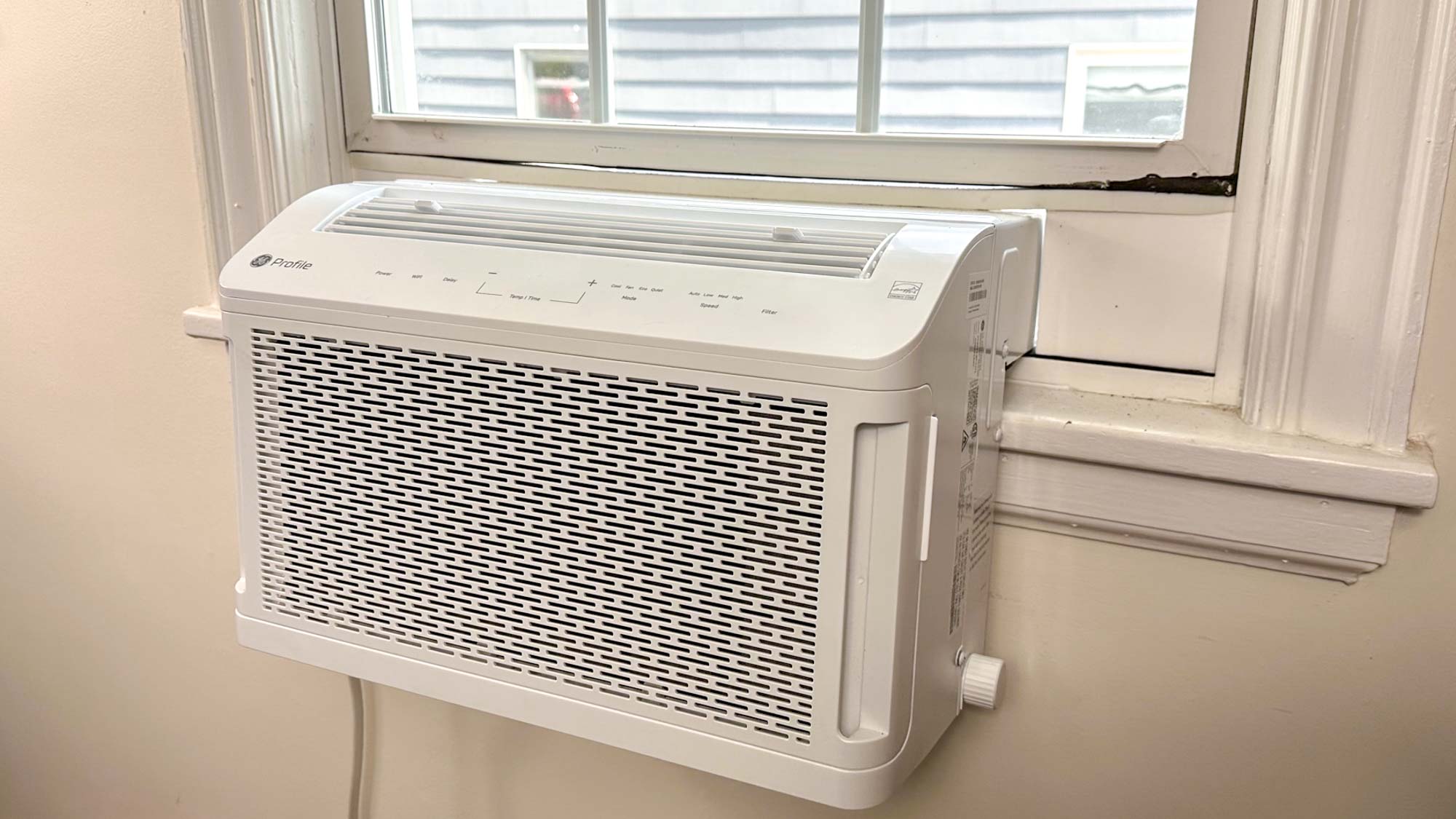
I liked that the Clearview directs air upwards; for one, it lets the air cascade down, rather than blowing it directly on you. The touch controls were also easy to use, and responded instantly to my presses.
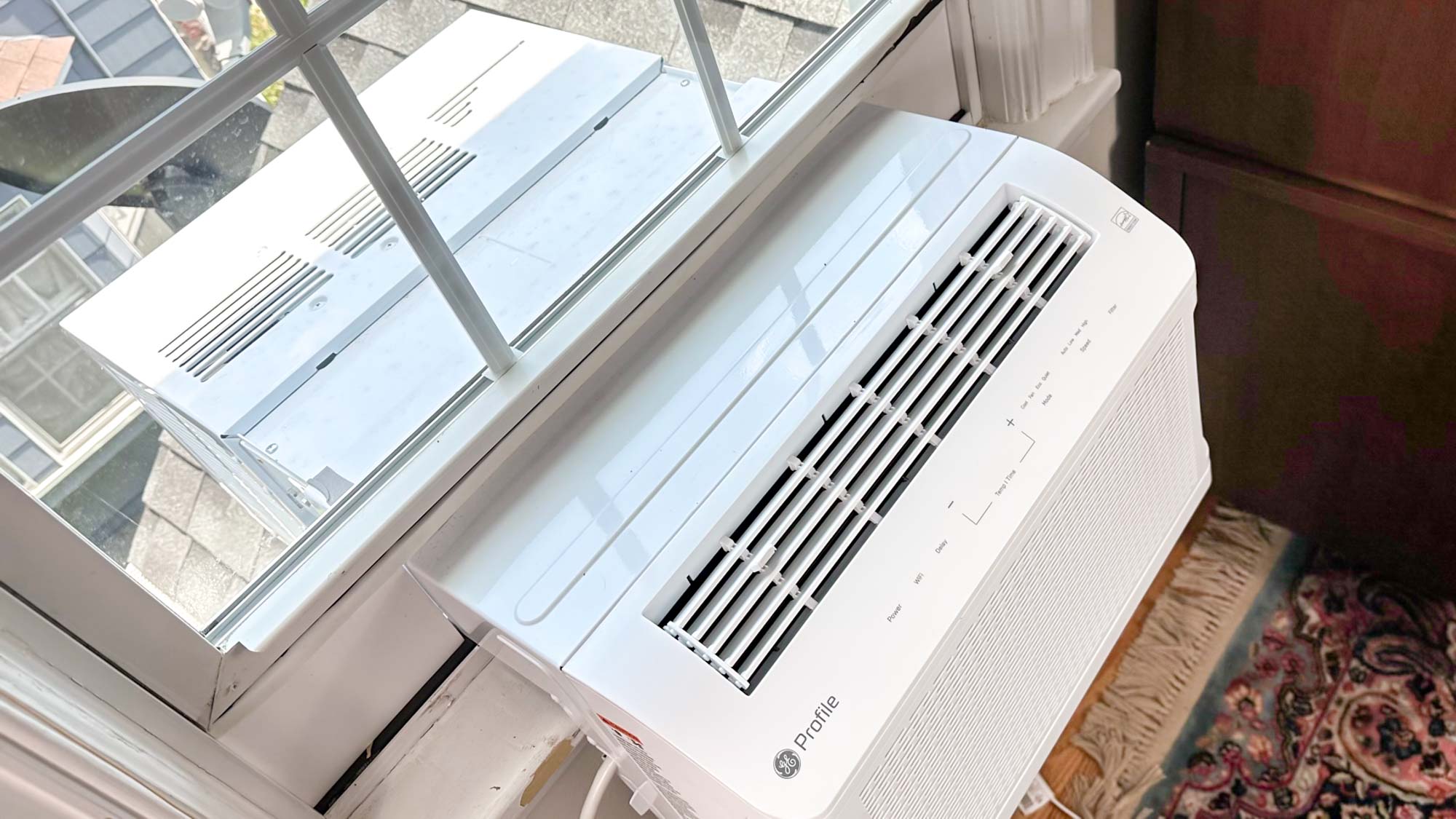
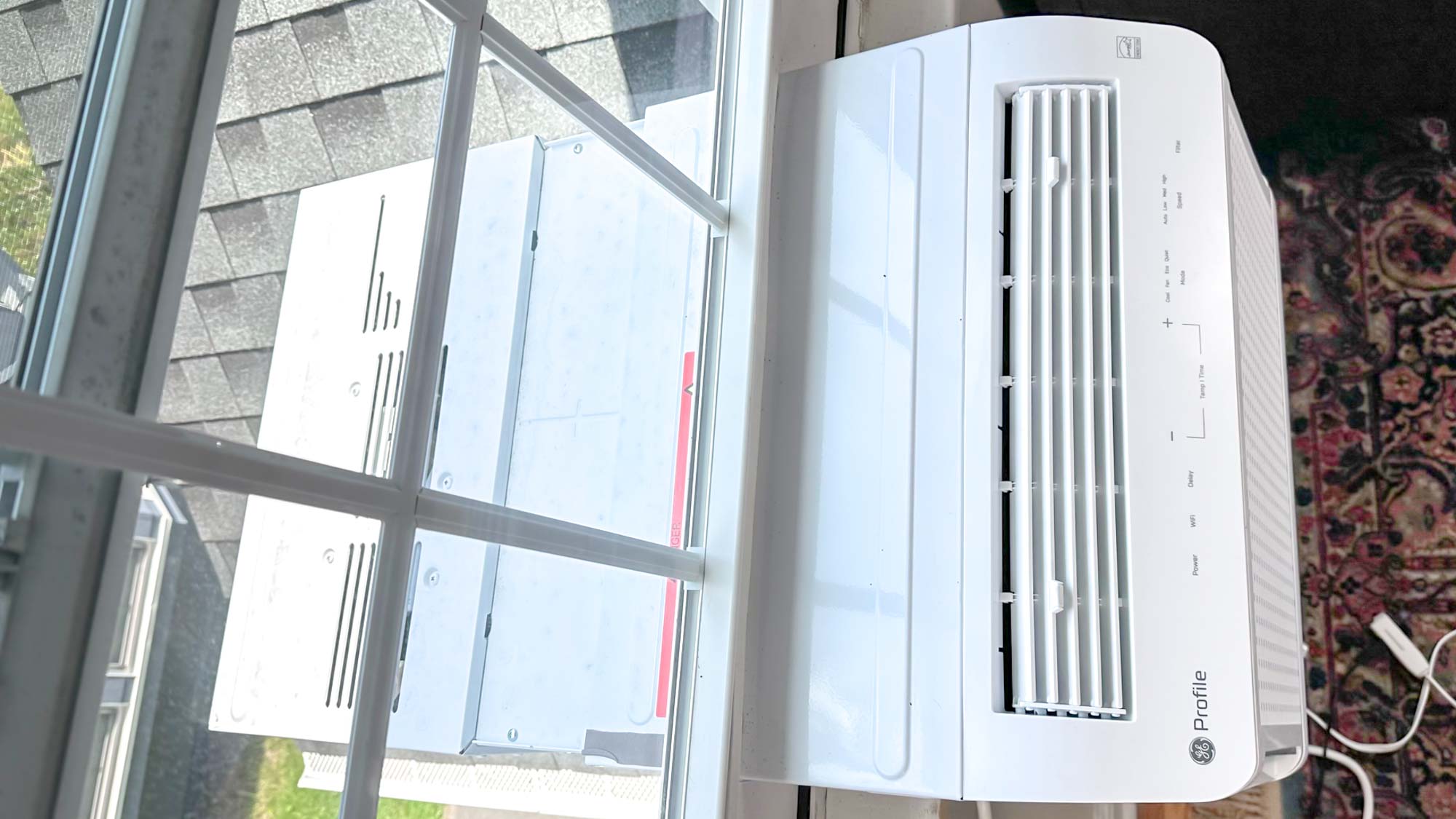
However, I wasn’t as enamored of the Clearview’s design as I was the Midea. Measuring from the window, the Midea unit protrudes about 8.5 inches into the room. The Clearview, by contrast, sticks out about 13 inches. And, because it doesn’t wrap around the window sill, there’s a big gap between the back side of the Clearview and the wall underneath your window.
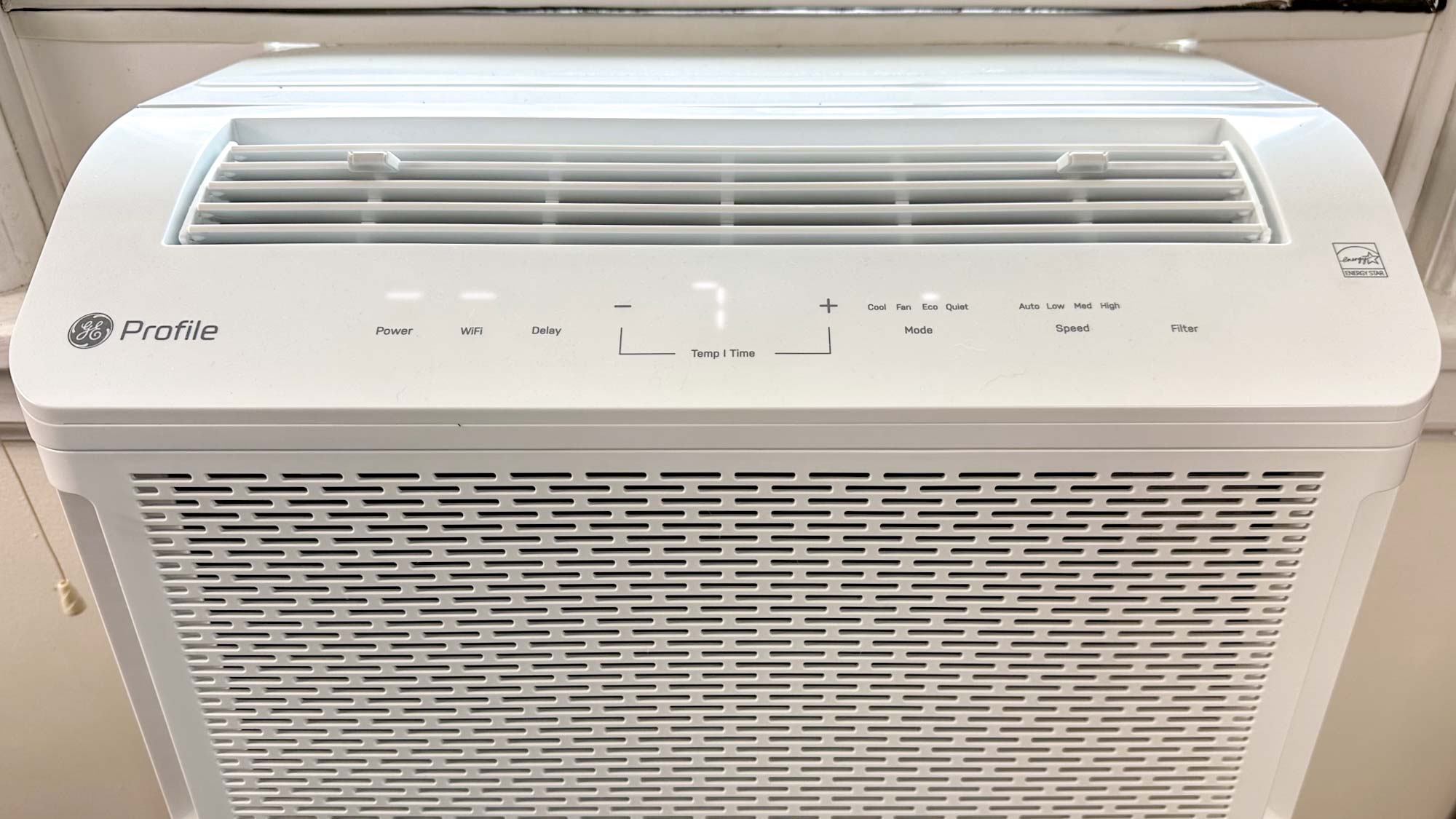
GE Profile Clearview Window air conditioner review: Installation
Installing the GE Profile Clearview window air conditioner was much more fussy than with other window air conditioners I’ve tested. The Clearview can be expanded to three different sizes, so that it can fit various window sill widths, up to 13.75 inches. However, finding the best size proved tricky; I — and my wife — had to place and remove the air conditioner three times before I got it right, which was no small feat, considering it weighs 80 pounds. In the process, we managed to scrape some of the paint off our window sill, too.
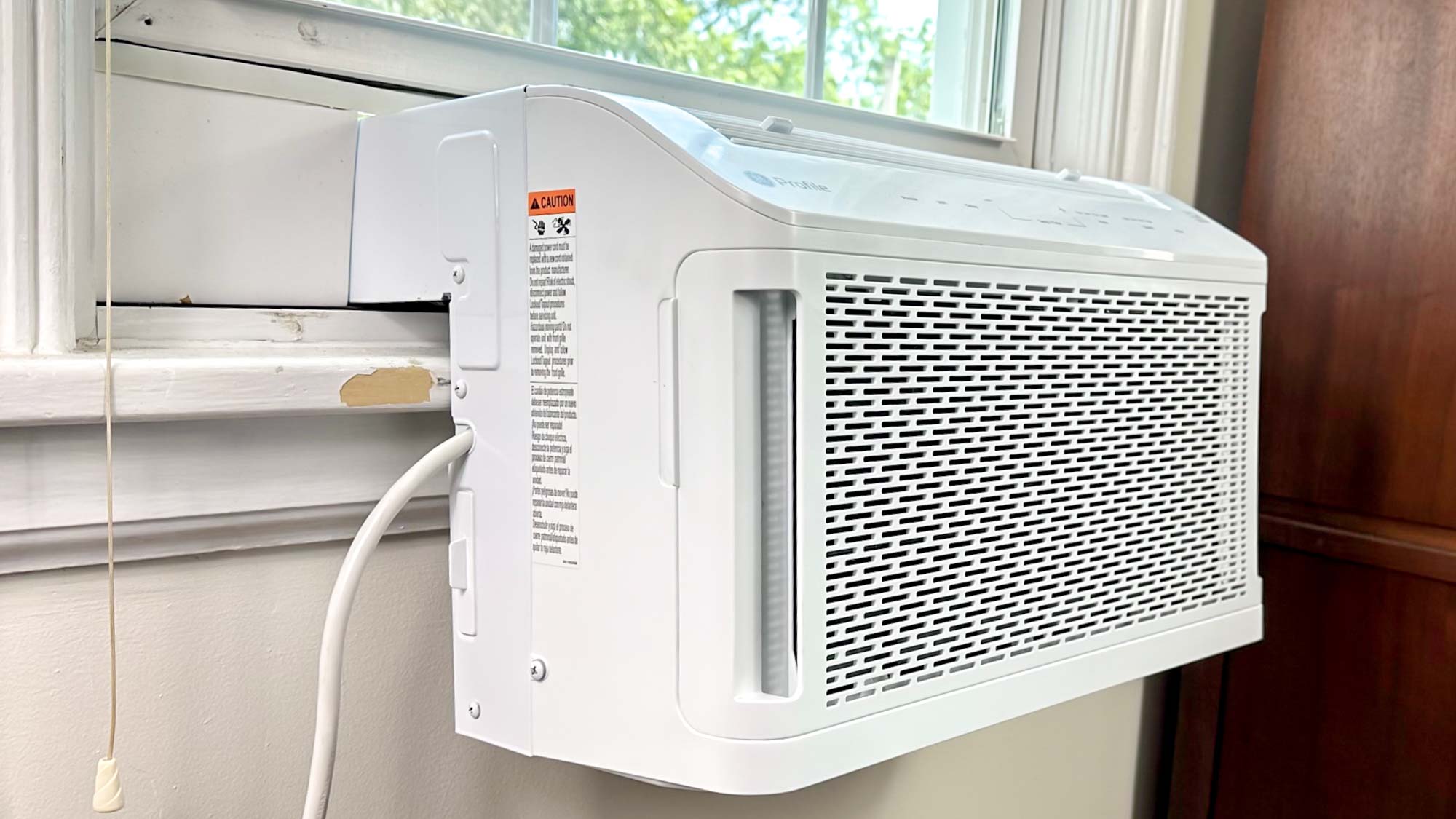
Once you figure out the correct size and place the air conditioner in your window, you then have to reach outside and adjust two rubber feet by turning them until the air conditioner is snug against the outside of your house. The whole time I was turning each foot, I was nervous that the whole AC would flip and fly out my window.
The hard part over, I then cut the included foam blocks to size, and then lowered the window to make everything snug.
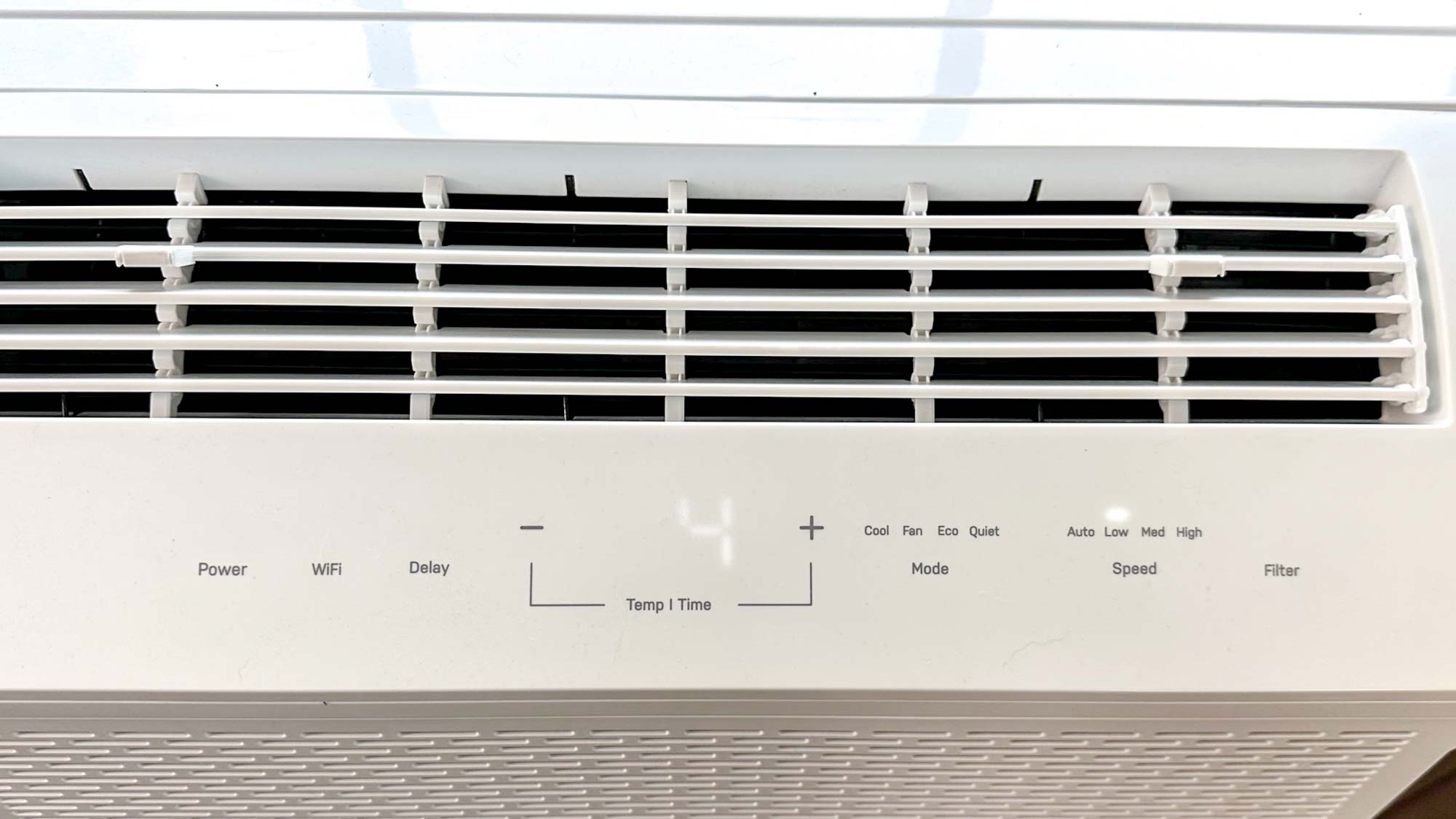
Installing the GE Profile Clearview window air conditioner was much more fussy than with other window air conditioners I’ve tested.
I also had a little trouble connecting the air conditioner to the SmartHQ app, mostly due to confusion on my part. Yes, even someone as seasoned as I can have trouble setting up smart home devices. Fortunately, a call to GE’s tech support, and Travis quickly and expertly diagnosed and helped me fix the problem.
GE Profile Clearview Window air conditioner review: Performance
It took until July, but the weather finally heated up in my area, and I was glad to have the GE Profile Clearview cooling my bedroom, rather than the older, noisier air conditioner I had been using. It cooled my 13 x 10-foot bedroom in no time at all, and did so quietly.
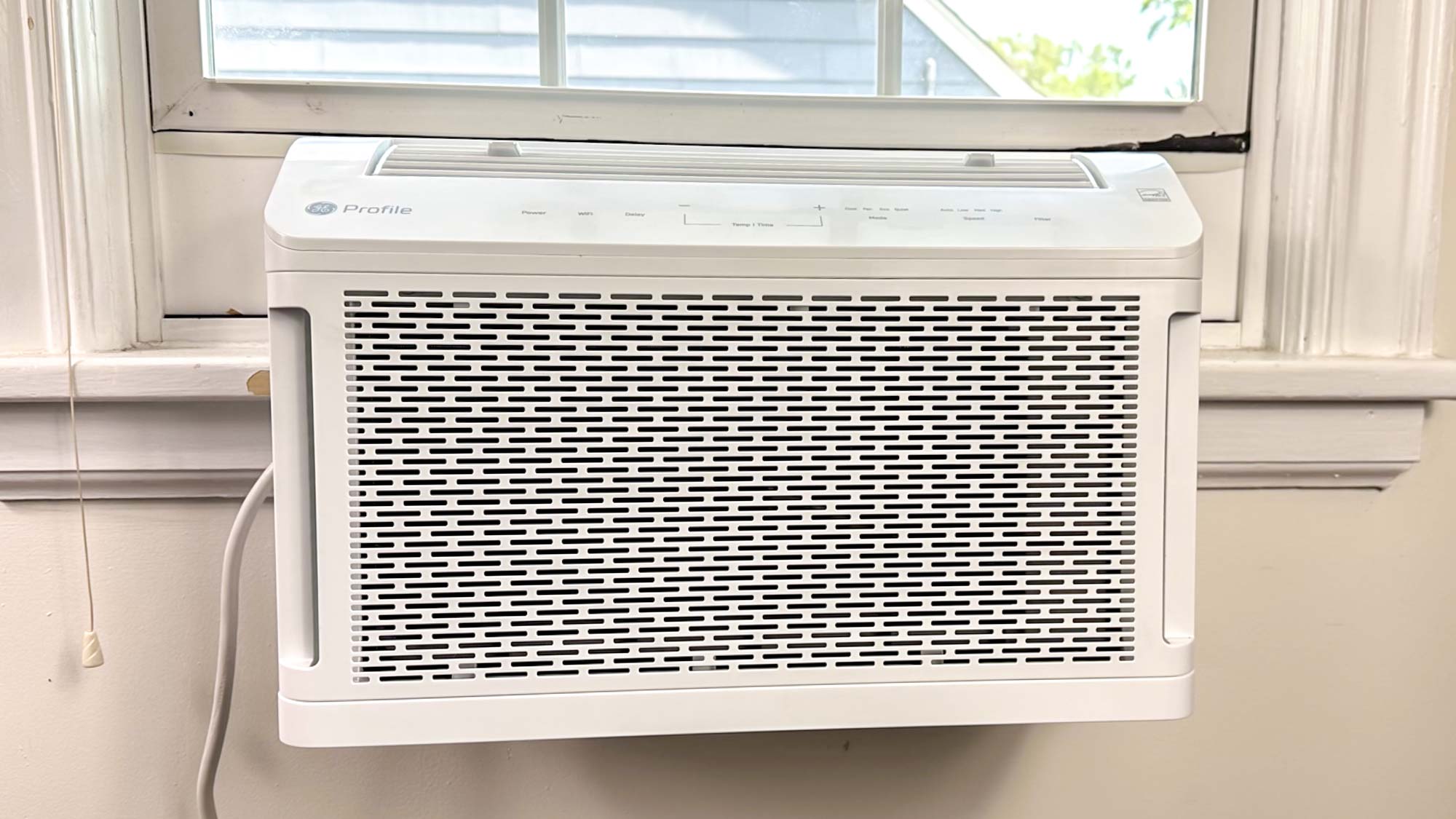
In Eco mode and with the fan on low, the Clearview measured about 45 decibels from 10 feet away. That’s not quite as quiet as the advertised 40dB, but it’s still pretty soft. Turning the fan speed to high, the noise increased to 50 decibels — again, not too shabby. In everyday use, I would say it was about as loud as the Midea unit.
The Clearview’s Energy Saver mode indeed seemed like it was saving energy — by not turning on the air conditioner. Before bed one evening, I set it to Energy Saver, and it cooled down the room, but then did not turn on again, presumably because our room was at the set temperature. However, there was no air movement, so things became stuffy. I then turned the A/C to the Cool setting, with the fan speed on low.
I was glad to have the GE Profile Clearview in my bedroom instead of the the older, noisier air conditioner I had been using. It cooled my 13 x 10-foot bedroom in no time at all, and did so quietly.
The Clearview’s control panel was easy to use, but has an annoying trait. After a certain period of time, all of the lights on the panel turn off. While it’s nice that it doesn’t blind you at night, if the A/C isn’t actively working, it gives the appearance that the entire machine is off. You have to tap the power button once to turn the lights on, and then tap on the button(s) you need to change temperature, etc.
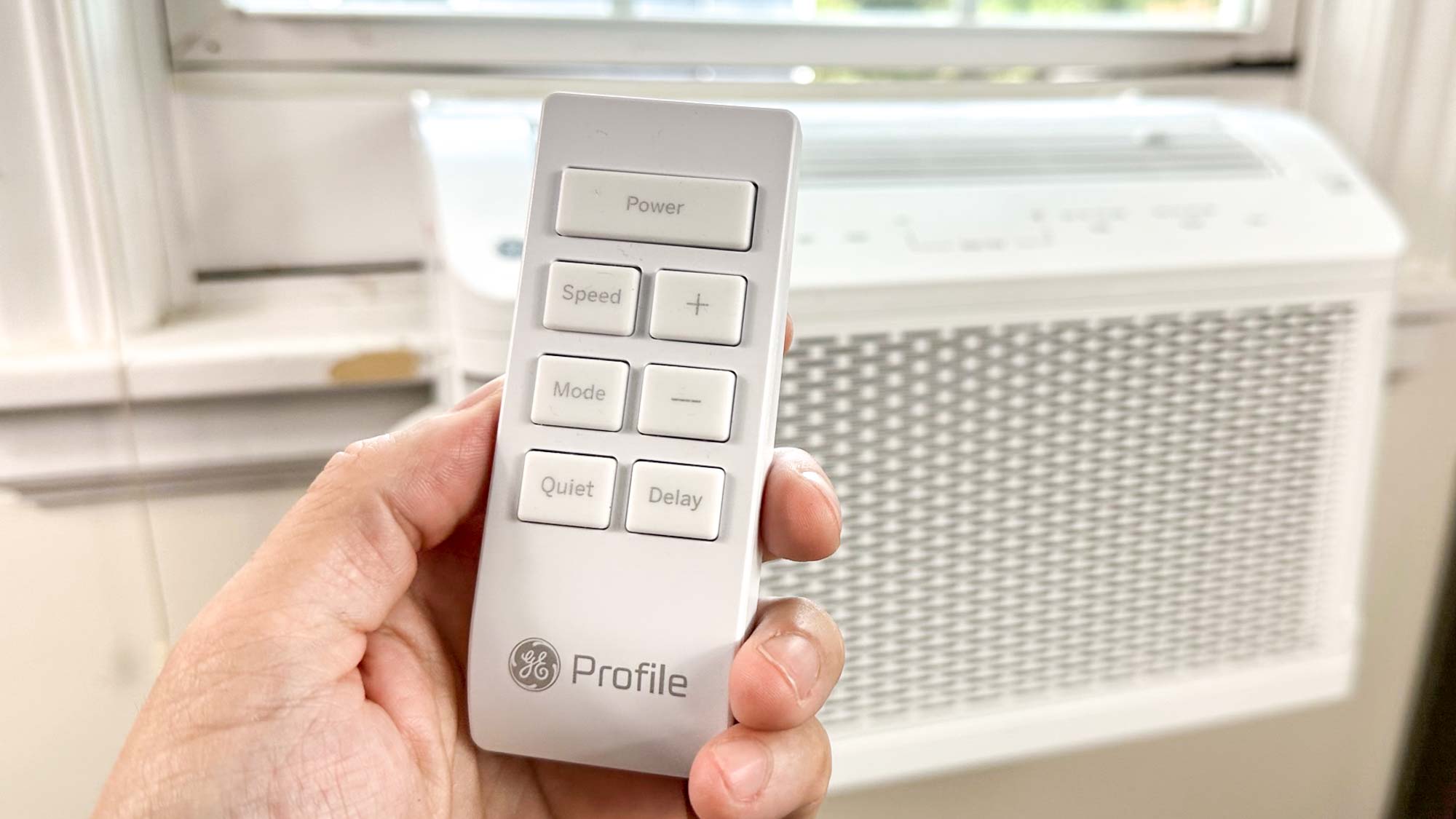
The Clearview comes with a small white remote control that lets you adjust the temperature, change modes, and more. The buttons are soft and easy to press, but I found that the gray writing on the buttons was incredibly hard to read, especially in dim lighting
GE Profile Clearview Window air conditioner review: App
The SmartHQ app, which is used to control the GE Profile Clearview air conditioner and other connected GE appliances has a friendly, easy-to-use interface. It’s not overly complicated, and shows you the mode the air conditioner is in (Cool, Energy Saver, Silent mode) as well as the fan speed and temperature. The only thing I’d tweak here is the temperature readout: It displays both the room temperature and the temperature at which the air conditioner is set, but it’s not obvious which is which.
The app also lets you create a schedule as to when the air conditioner should turn on and off, and allows you to assign specific mode and temperature settings, too. Additionally, you can create location-based automations, so that the air conditioner will automatically turn on when you’re home, and turn off when you leave. You can also connect the air conditioner to Alexa, Google Assistant, and IFTTT if you want to automate its functions using those assistants.
GE Profile Clearview Window air conditioner review: Verdict
On paper, the GE Clearview window air conditioner looks like a great idea. It lets more light in than other window air conditioners, and it offers better insulation, too. However, its design made it much more difficult to install, and other little issues, such as the writing on the remote, dimmed my enthusiasm.
Not to mention that at $529, the GE Clearview is $110 more expensive than a comparable Midea window air conditioner. But, if you value getting more light through your window, the GE Profile Clearview might be worth the extra price.

Michael A. Prospero is the U.S. Editor-in-Chief for Tom’s Guide. He oversees all evergreen content and oversees the Homes, Smart Home, and Fitness/Wearables categories for the site. In his spare time, he also tests out the latest drones, electric scooters, and smart home gadgets, such as video doorbells. Before his tenure at Tom's Guide, he was the Reviews Editor for Laptop Magazine, a reporter at Fast Company, the Times of Trenton, and, many eons back, an intern at George magazine. He received his undergraduate degree from Boston College, where he worked on the campus newspaper The Heights, and then attended the Columbia University school of Journalism. When he’s not testing out the latest running watch, electric scooter, or skiing or training for a marathon, he’s probably using the latest sous vide machine, smoker, or pizza oven, to the delight — or chagrin — of his family.
-
CrisisofEducation So to be clear, the editor in chief of a prominent technology review site dings this AC and his own windowsill because he didn't use a measuring device such as a ruler, tape measure, hand, etc... was concerned that the laws of physio not apply to this unit and therefore the unit may flip out the window (remember he just said it weighs 80lbs and the weight is distributed primarily BELOW the windowsill) and he can't connect it to his WiFi. Did someone hack the site and post this review?Reply -
COLGeek I suggest you seal the edge between the AC unit and window better. Your photos really draw attention to a poorly sealed installation.Reply
